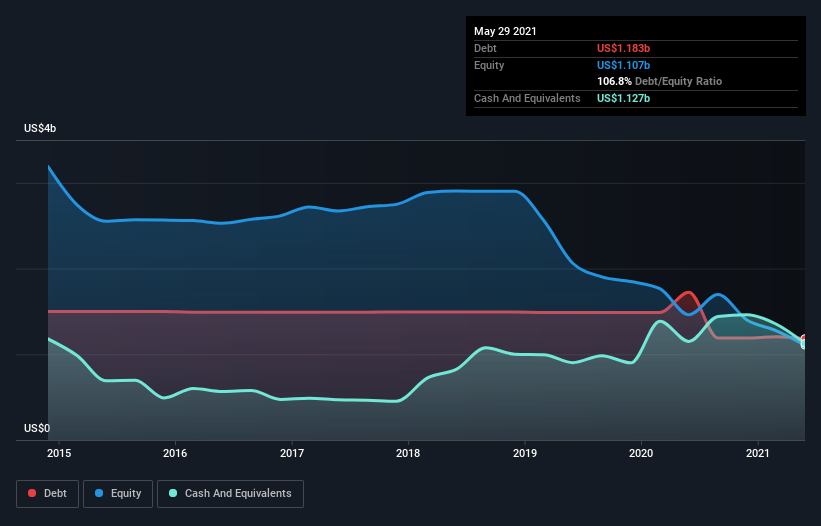- United States
- /
- Specialty Stores
- /
- OTCPK:BBBY.Q
These 4 Measures Indicate That Bed Bath & Beyond (NASDAQ:BBBY) Is Using Debt Extensively

The external fund manager backed by Berkshire Hathaway's Charlie Munger, Li Lu, makes no bones about it when he says 'The biggest investment risk is not the volatility of prices, but whether you will suffer a permanent loss of capital.' When we think about how risky a company is, we always like to look at its use of debt, since debt overload can lead to ruin. Importantly, Bed Bath & Beyond Inc. (NASDAQ:BBBY) does carry debt. But should shareholders be worried about its use of debt?
When Is Debt Dangerous?
Generally speaking, debt only becomes a real problem when a company can't easily pay it off, either by raising capital or with its own cash flow. In the worst case scenario, a company can go bankrupt if it cannot pay its creditors. While that is not too common, we often do see indebted companies permanently diluting shareholders because lenders force them to raise capital at a distressed price. Of course, plenty of companies use debt to fund growth, without any negative consequences. The first step when considering a company's debt levels is to consider its cash and debt together.
View our latest analysis for Bed Bath & Beyond
How Much Debt Does Bed Bath & Beyond Carry?
As you can see below, Bed Bath & Beyond had US$1.18b of debt at May 2021, down from US$1.72b a year prior. On the flip side, it has US$1.13b in cash leading to net debt of about US$55.3m.

How Strong Is Bed Bath & Beyond's Balance Sheet?
Zooming in on the latest balance sheet data, we can see that Bed Bath & Beyond had liabilities of US$2.05b due within 12 months and liabilities of US$2.89b due beyond that. On the other hand, it had cash of US$1.13b and US$318.1m worth of receivables due within a year. So it has liabilities totalling US$3.50b more than its cash and near-term receivables, combined.
The deficiency here weighs heavily on the US$2.31b company itself, as if a child were struggling under the weight of an enormous back-pack full of books, his sports gear, and a trumpet. So we'd watch its balance sheet closely, without a doubt. At the end of the day, Bed Bath & Beyond would probably need a major re-capitalization if its creditors were to demand repayment.
In order to size up a company's debt relative to its earnings, we calculate its net debt divided by its earnings before interest, tax, depreciation, and amortization (EBITDA) and its earnings before interest and tax (EBIT) divided by its interest expense (its interest cover). The advantage of this approach is that we take into account both the absolute quantum of debt (with net debt to EBITDA) and the actual interest expenses associated with that debt (with its interest cover ratio).
With net debt at just 0.071 times EBITDA, it seems Bed Bath & Beyond only uses a little bit of leverage. Although with EBIT only covering interest expenses 6.0 times over, the company is truly paying for borrowing. It was also good to see that despite losing money on the EBIT line last year, Bed Bath & Beyond turned things around in the last 12 months, delivering and EBIT of US$454m. When analysing debt levels, the balance sheet is the obvious place to start. But it is future earnings, more than anything, that will determine Bed Bath & Beyond's ability to maintain a healthy balance sheet going forward. So if you're focused on the future you can check out this free report showing analyst profit forecasts.
Finally, a business needs free cash flow to pay off debt; accounting profits just don't cut it. So it's worth checking how much of the earnings before interest and tax (EBIT) is backed by free cash flow. During the last year, Bed Bath & Beyond generated free cash flow amounting to a very robust 92% of its EBIT, more than we'd expect. That puts it in a very strong position to pay down debt.
Our View
We feel some trepidation about Bed Bath & Beyond's difficulty level of total liabilities, but we've got positives to focus on, too. To wit both its conversion of EBIT to free cash flow and net debt to EBITDA were encouraging signs. Looking at all the angles mentioned above, it does seem to us that Bed Bath & Beyond is a somewhat risky investment as a result of its debt. Not all risk is bad, as it can boost share price returns if it pays off, but this debt risk is worth keeping in mind. There's no doubt that we learn most about debt from the balance sheet. But ultimately, every company can contain risks that exist outside of the balance sheet. To that end, you should be aware of the 4 warning signs we've spotted with Bed Bath & Beyond .
At the end of the day, it's often better to focus on companies that are free from net debt. You can access our special list of such companies (all with a track record of profit growth). It's free.
Valuation is complex, but we're here to simplify it.
Discover if Bed Bath & Beyond might be undervalued or overvalued with our detailed analysis, featuring fair value estimates, potential risks, dividends, insider trades, and its financial condition.
Access Free AnalysisThis article by Simply Wall St is general in nature. We provide commentary based on historical data and analyst forecasts only using an unbiased methodology and our articles are not intended to be financial advice. It does not constitute a recommendation to buy or sell any stock, and does not take account of your objectives, or your financial situation. We aim to bring you long-term focused analysis driven by fundamental data. Note that our analysis may not factor in the latest price-sensitive company announcements or qualitative material. Simply Wall St has no position in any stocks mentioned.
Have feedback on this article? Concerned about the content? Get in touch with us directly. Alternatively, email editorial-team (at) simplywallst.com.
About OTCPK:BBBY.Q
Bed Bath & Beyond
Bed Bath & Beyond Inc., together with its subsidiaries, operates a chain of retail stores.
Moderate and slightly overvalued.
Similar Companies
Market Insights
Community Narratives



